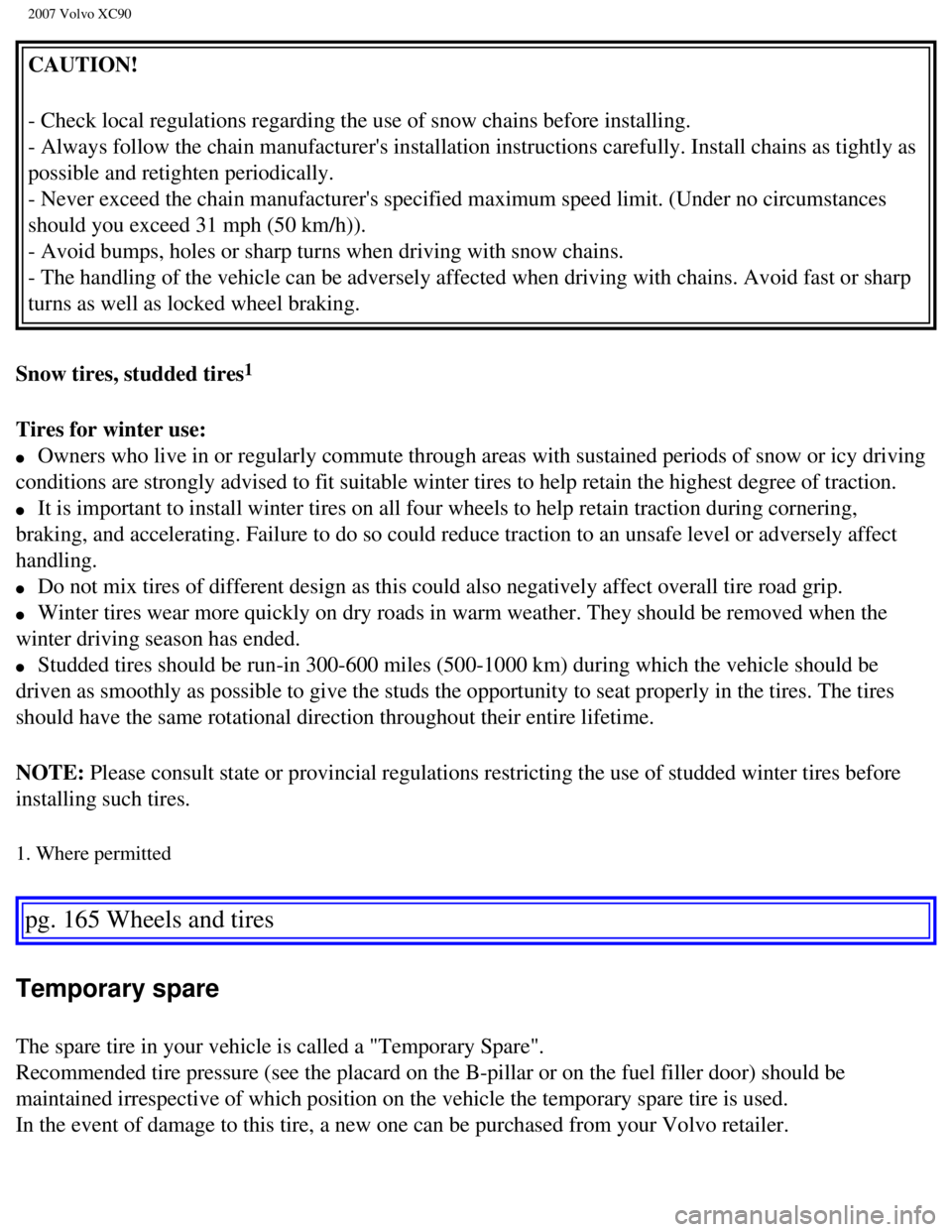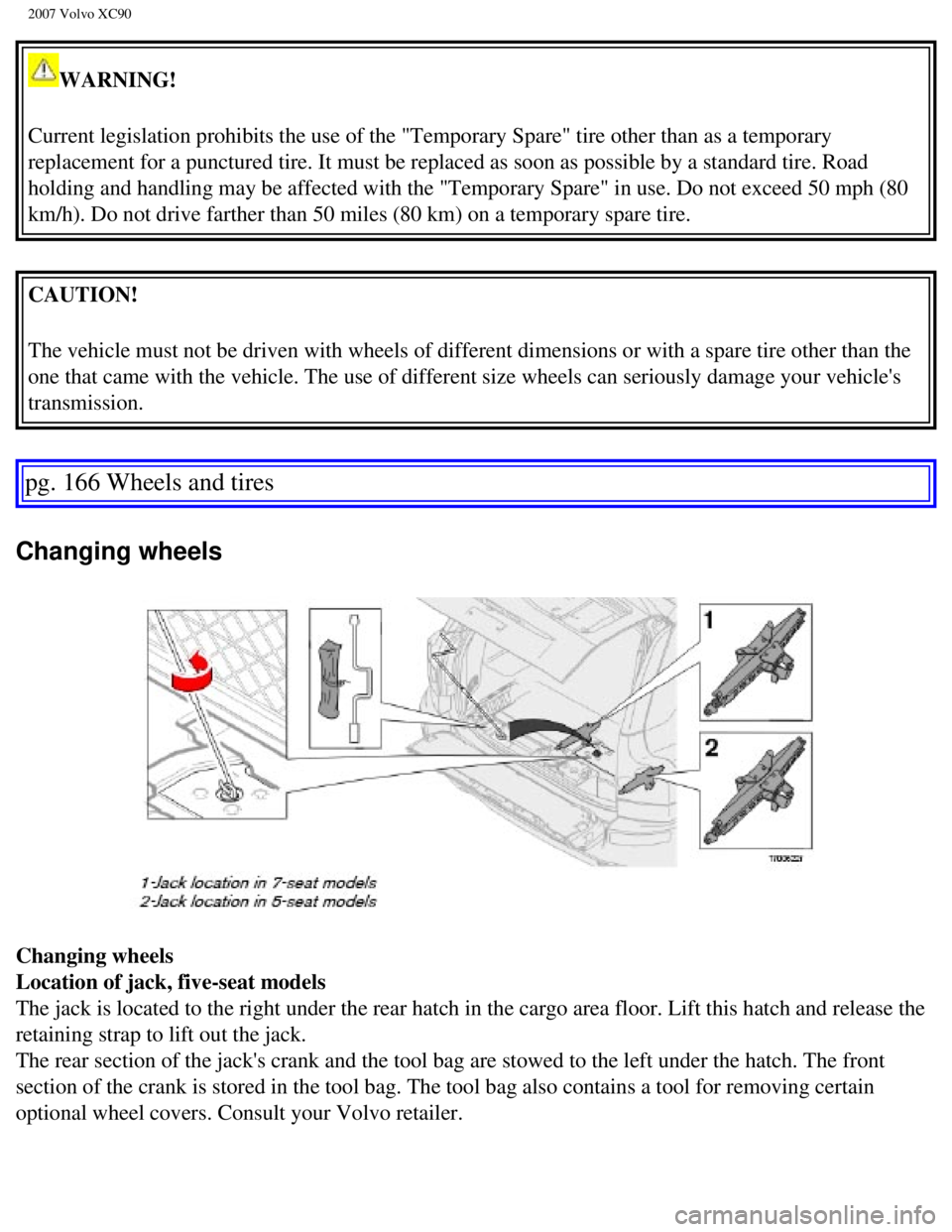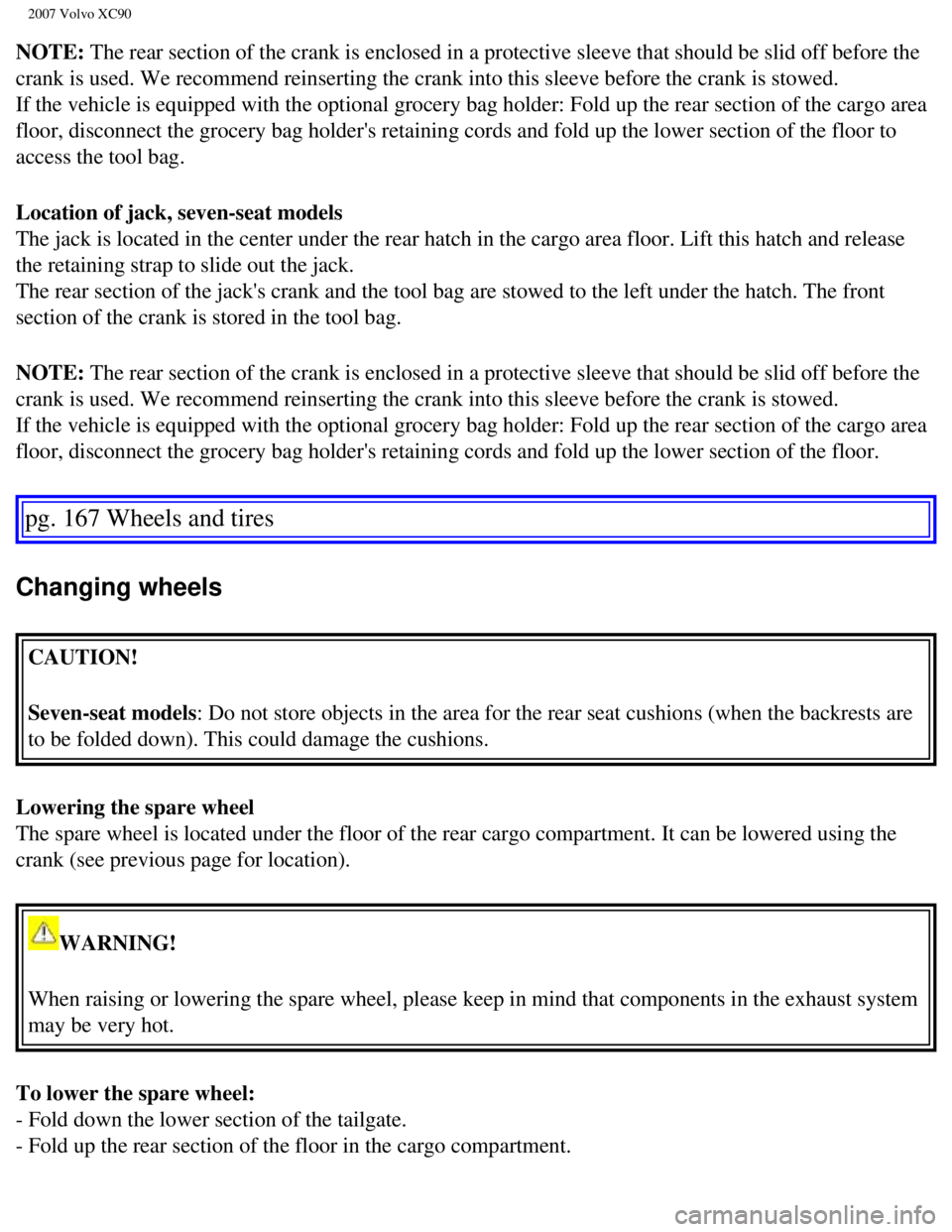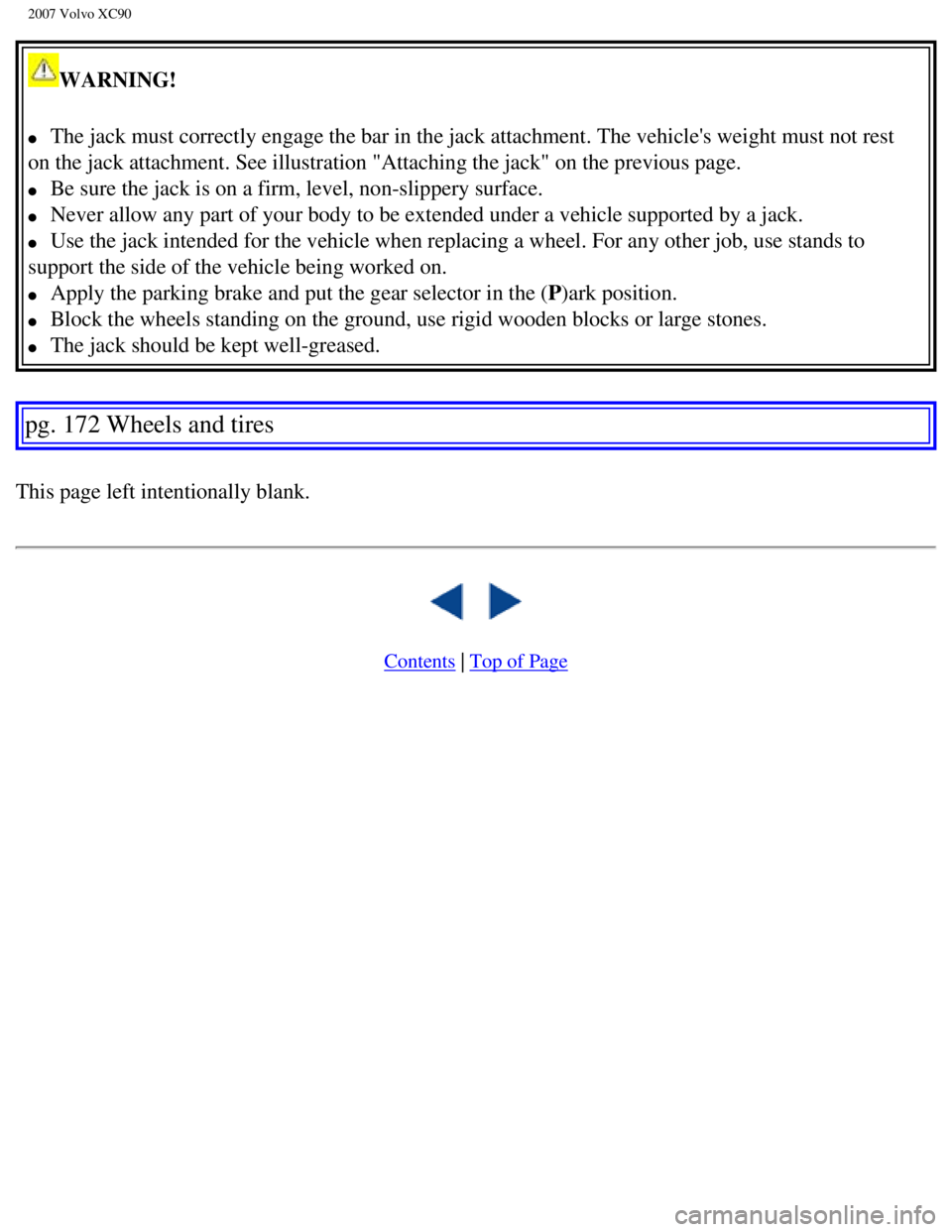2007 VOLVO XC90 tires
[x] Cancel search: tiresPage 172 of 268

2007 Volvo XC90
CAUTION!
- Check local regulations regarding the use of snow chains before instal\
ling.
- Always follow the chain manufacturer's installation instructions caref\
ully. Install chains as tightly as
possible and retighten periodically.
- Never exceed the chain manufacturer's specified maximum speed limit. (\
Under no circumstances
should you exceed 31 mph (50 km/h)).
- Avoid bumps, holes or sharp turns when driving with snow chains.
- The handling of the vehicle can be adversely affected when driving wit\
h chains. Avoid fast or sharp
turns as well as locked wheel braking.
Snow tires, studded tires
1
Tires for winter use:
l Owners who live in or regularly commute through areas with sustained per\
iods of snow or icy driving
conditions are strongly advised to fit suitable winter tires to help ret\
ain the highest degree of traction.
l It is important to install winter tires on all four wheels to help retai\
n traction during cornering,
braking, and accelerating. Failure to do so could reduce traction to an \
unsafe level or adversely affect
handling.
l Do not mix tires of different design as this could also negatively affec\
t overall tire road grip.
l Winter tires wear more quickly on dry roads in warm weather. They should\
be removed when the
winter driving season has ended.
l Studded tires should be run-in 300-600 miles (500-1000 km) during whic\
h the vehicle should be
driven as smoothly as possible to give the studs the opportunity to seat\
properly in the tires. The tires
should have the same rotational direction throughout their entire lifeti\
me.
NOTE: Please consult state or provincial regulations restricting the use of s\
tudded winter tires before
installing such tires.
1. Where permitted
pg. 165 Wheels and tires
Temporary spare
The spare tire in your vehicle is called a "Temporary Spare".
Recommended tire pressure (see the placard on the B-pillar or on the fu\
el filler door) should be
maintained irrespective of which position on the vehicle the temporary s\
pare tire is used.
In the event of damage to this tire, a new one can be purchased from you\
r Volvo retailer.
file:///K|/ownersdocs/2007/2007_XC90/07xc90_07.htm (16 of 23)12/30/200\
6 5:53:47 PM
Page 173 of 268

2007 Volvo XC90
WARNING!
Current legislation prohibits the use of the "Temporary Spare" tire othe\
r than as a temporary
replacement for a punctured tire. It must be replaced as soon as possibl\
e by a standard tire. Road
holding and handling may be affected with the "Temporary Spare" in use. \
Do not exceed 50 mph (80
km/h). Do not drive farther than 50 miles (80 km) on a temporary spar\
e tire.
CAUTION!
The vehicle must not be driven with wheels of different dimensions or wi\
th a spare tire other than the
one that came with the vehicle. The use of different size wheels can ser\
iously damage your vehicle's
transmission.
pg. 166 Wheels and tires
Changing wheels
Changing wheels
Location of jack, five-seat models
The jack is located to the right under the rear hatch in the cargo area \
floor. Lift this hatch and release the
retaining strap to lift out the jack.
The rear section of the jack's crank and the tool bag are stowed to the \
left under the hatch. The front
section of the crank is stored in the tool bag. The tool bag also contai\
ns a tool for removing certain
optional wheel covers. Consult your Volvo retailer.
file:///K|/ownersdocs/2007/2007_XC90/07xc90_07.htm (17 of 23)12/30/200\
6 5:53:47 PM
Page 174 of 268

2007 Volvo XC90
NOTE: The rear section of the crank is enclosed in a protective sleeve that s\
hould be slid off before the
crank is used. We recommend reinserting the crank into this sleeve befor\
e the crank is stowed.
If the vehicle is equipped with the optional grocery bag holder: Fold up\
the rear section of the cargo area
floor, disconnect the grocery bag holder's retaining cords and fold up t\
he lower section of the floor to
access the tool bag.
Location of jack, seven-seat models
The jack is located in the center under the rear hatch in the cargo area\
floor. Lift this hatch and release
the retaining strap to slide out the jack.
The rear section of the jack's crank and the tool bag are stowed to the \
left under the hatch. The front
section of the crank is stored in the tool bag.
NOTE: The rear section of the crank is enclosed in a protective sleeve that s\
hould be slid off before the
crank is used. We recommend reinserting the crank into this sleeve befor\
e the crank is stowed.
If the vehicle is equipped with the optional grocery bag holder: Fold up\
the rear section of the cargo area
floor, disconnect the grocery bag holder's retaining cords and fold up t\
he lower section of the floor.
pg. 167 Wheels and tires
Changing wheels
CAUTION!
Seven-seat models: Do not store objects in the area for the rear seat cushions (when the\
backrests are
to be folded down). This could damage the cushions.
Lowering the spare wheel
The spare wheel is located under the floor of the rear cargo compartment\
. It can be lowered using the
crank (see previous page for location).
WARNING!
When raising or lowering the spare wheel, please keep in mind that compo\
nents in the exhaust system
may be very hot.
To lower the spare wheel:
- Fold down the lower section of the tailgate.
- Fold up the rear section of the floor in the cargo compartment.
file:///K|/ownersdocs/2007/2007_XC90/07xc90_07.htm (18 of 23)12/30/200\
6 5:53:47 PM
Page 175 of 268

2007 Volvo XC90
- Connect the two sections of the jack's crank.
- Insert the hooked end of the crank in the spare wheel retaining attach\
ment (see the illustration below).
- Lower the spare wheel under the vehicle by turning the crank countercl\
ockwise until it is not possible
to turn it further.
- Pivot the toggle at the end of the cable 90 degrees to release it from\
the spare wheel
- Crank up the cable again by turning the crank clockwise. CAUTION!
When the spare wheel is mounted on the vehicle, the retaining cable coul\
d damage the underside of
the vehicle if it is not retracted.
- Place the wheel with the flat tire in the vehicle's cargo compartment.\
NOTE: The space under the vehicle is designed to hold the special spare wheel\
only. Other full-size
wheels will not fit in this compartment.
Returning the spare wheel to the storage compartment
- Use the crank (turn it counterclockwise) to lower the spare wheel's \
retaining cable.
- Pass the toggle at the end of the cable through the center hole in the\
spare wheel. Pivot the toggle 90
degrees so that when raised, the wheel will rest on the toggle.
- Retract the retaining cable slightly by slowly turning the crank clock\
wise several times.
- Position the wheel so that it is not obstructed by components in the e\
xhaust system.
pg. 168 Wheels and tires
Changing wheels
- Continue to raise the wheel by turning the crank clockwise. Raise the \
wheel a little bit at a time and
file:///K|/ownersdocs/2007/2007_XC90/07xc90_07.htm (19 of 23)12/30/200\
6 5:53:47 PM
Page 177 of 268

2007 Volvo XC90
WARNING!
The undersides of accessory running boards are not intended for attachin\
g the
jack.
Changing a wheel
- Park the vehicle on a firm, level, non-slippery surface.
- Engage the parking brake and put the gear selector in the Park positio\
n.
- Loosen the wheel bolts by exerting downward pressure on the lug wrench\
.
- Remove the wheel cap (where applicable) using the lug wrench in the \
tool bag.
pg. 169 Wheels and tires
Changing wheels
- With the wheels still on the ground, use the lug wrench to loosen the \
wheel bolts 1/2 - 1 turn. Turn the
bolts counterclockwise to loosen the bolts.
CAUTION!
- The vehicle must not be driven with wheels of different dimensions or \
with a spare tire other than
the one that came with the vehicle. The use of different size wheels can\
seriously damage your
vehicle's transmission.
- Correct tightening torque on wheel bolts must be observed.
- The wheel bolts should never be greased or lubricated.
- Extended, chromed wheel bolts must not be used with steel rims, as the\
y make it impossible to fit
the hub caps.
pg. 170 Wheels and tires
Changing wheels
file:///K|/ownersdocs/2007/2007_XC90/07xc90_07.htm (21 of 23)12/30/200\
6 5:53:47 PM
Page 178 of 268

2007 Volvo XC90
- Place the jack on the ground, under one of the attachment points (see\
the illustration on the previous
page) and crank while simultaneously guiding the jack's attachment brac\
ket onto the attachment point
(see illustration above) The base of the jack must be flat on a level,\
firm, non-slippery surface. Before
raising the vehicle, check that the jack is still correctly positioned i\
n the attachment.
- Raise the vehicle until the wheel to be changed is lifted off the grou\
nd.
- Unscrew the wheel bolts completely and carefully remove the wheel so a\
s not to damage the threads on
the studs.
NOTE: To avoid excessive wear and the necessity of rebalancing, mark and rein\
stall wheels in the same
location and position as before removal. To lessen the chance of imbalan\
ce, each wheel hub is equipped
with a guide stud to ensure that a removed wheel can be reinstalled in i\
ts original position (as when
changing over to winter tires/wheels).
Installing the wheel
- Clean the contact surfaces on the wheel and hub.
- Lift the wheel and place it on the hub.
- Install the wheel bolts and tighten hand-tight. Using the lug wrench, \
tighten crosswise until all bolts are
snug.
- Lower the vehicle to the ground and alternately tighten the bolts cros\
swise to 102 ft. lbs. (140 Nm).
- Install the wheel cap (where applicable).
pg. 171 Wheels and tires
Changing wheels
file:///K|/ownersdocs/2007/2007_XC90/07xc90_07.htm (22 of 23)12/30/200\
6 5:53:47 PM
Page 179 of 268

2007 Volvo XC90
WARNING!
l The jack must correctly engage the bar in the jack attachment. The vehic\
le's weight must not rest
on the jack attachment. See illustration "Attaching the jack" on the pre\
vious page.
l Be sure the jack is on a firm, level, non-slippery surface.
l Never allow any part of your body to be extended under a vehicle support\
ed by a jack.
l Use the jack intended for the vehicle when replacing a wheel. For any ot\
her job, use stands to
support the side of the vehicle being worked on.
l Apply the parking brake and put the gear selector in the (P)ark position.
l Block the wheels standing on the ground, use rigid wooden blocks or larg\
e stones.
l The jack should be kept well-greased.
pg. 172 Wheels and tires
This page left intentionally blank.
Contents | Top of Page
file:///K|/ownersdocs/2007/2007_XC90/07xc90_07.htm (23 of 23)12/30/200\
6 5:53:47 PM
Page 189 of 268

2007 Volvo XC90
pg. 181 Maintenance
Maintaining your car
Owner maintenance
Periodic maintenance requirements and intervals are described in your ve\
hicle's Warranty and Service
Records Information booklet.
The following points can be carried out between the normally scheduled m\
aintenance services.
Each time the vehicle is refueled:
l Check the engine oil level
l Clean the windshield, windshield wipers, headlights, and tail lights
Monthly:
l Check cold tire pressure in all tires. Inspect the tires for wear.
l Check that engine coolant and other fluid levels are between the indicat\
ed "min" and "max" markings.
l Clean interior glass surfaces with a glass cleaner and soft paper towels\
.
l Wipe driver information displays with a soft cloth.
l Visually inspect battery terminals for corrosion. Corrosion may indicate\
a loose terminal connector, or
a battery near the end of its useful service life. Consult your Volvo re\
tailer for additional information.
As needed:
l Wash the vehicle, including the undercarriage, to reduce wear that can b\
e caused by a buildup of dirt,
and corrosion that can be caused by salt residues.
l Clean leaves and twigs from air intake vents at the base of the windshie\
ld, and from other places
where they may collect.
NOTE: Complete service information for qualified technicians is available onl\
ine for purchase or
subscription at
www.volvotechinfo.com.
pg. 182 Maintenance
Emission inspection readiness
What is an Onboard Diagnostic System (OBD II)?
OBD II is part of your vehicle's computerized engine management system. \
It stores diagnostic
information about your vehicle's emission controls. It can light the Che\
ck Engine light (MIL) if it detects
an emission control "fault." A "fault" is a component or system that is \
not performing within an expected
range. A fault may be permanent or temporary. OBD II will store a messag\
e about any fault.
file:///K|/ownersdocs/2007/2007_XC90/07xc90_09.htm (3 of 37)12/30/2006\
5:53:50 PM